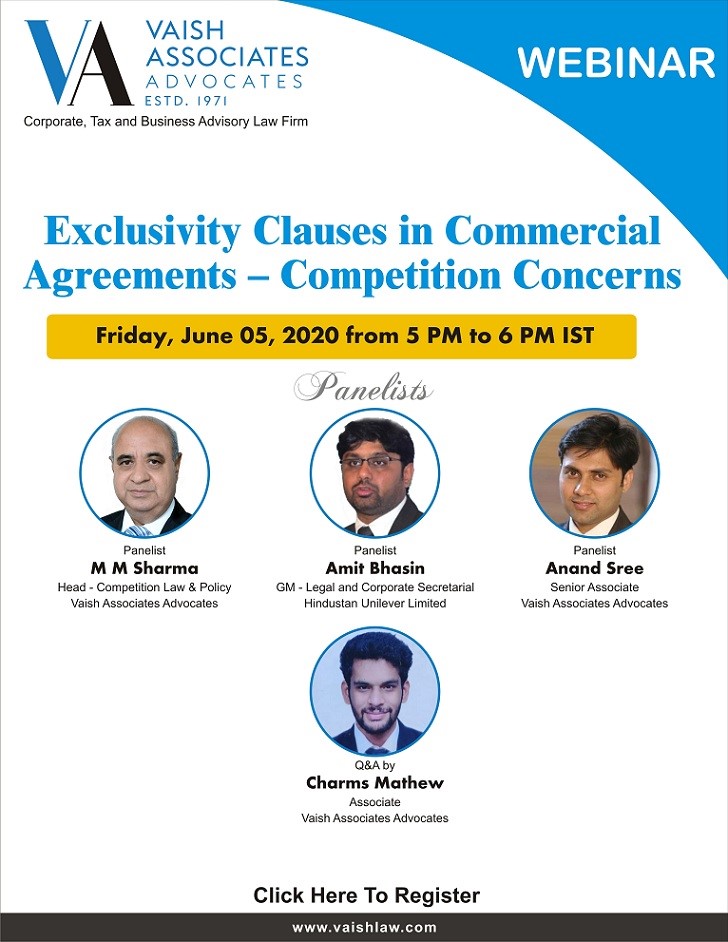WEBINAR ON EXCLUSIVE CLAUSES IN COMMERCIAL AGREEMENTS: COMPETITION CONCERNS – 5TH JUNE 2020
While continuing to fight the Covid-19 Pandemic and working from home, like most other lawyers in India, knowledge dissemination has proved to be a silver lining. I decided to conduct a series of webinars on antitrust issues of larger importance. I am thankful to my Law Firm, Vaish Associates to agree to my suggestion and provided me the platform.
Accordingly, our first webinar in this series on “Exclusive Clauses in Commercial Agreements -Competition Concerns” was held on 5th June 2020.
In the above webinar, I was joined by Mr Amit Bhasin, GM (Legal) , Hindustan Unilever and my team’s senior associate , Mr. Anand Sree .
I am reproducing hereunder the summary of the text of my power point (PPT) presentation during the webinar. The PPT presented during the webinar can be viewed in the video recording of the webinar here.
‘Exclusivity clauses in commercial agreement: competition concerns”. In most commercial agreements the exclusivity clauses are entered under the caption of “Non-compete clause”.
After the lockdown , I was thinking to organize webinars based on experience of various opinions given on this issue and the desire expressed by some of our clients to update knowledge on this topic which is fairly common business practice. Particularly , I was prompted to take this issue as the first in our Knowledge up dation series on competition law, due to a recent decision by CCI in March this year against a large industrial house , Grasim Industries Ltd., for abusing its dominant position by forcing exclusive supplies on its buyers by asking monthly production data for calculating the discount rate applicable to them and following a non-transparent and discriminatory pricing policy for giving discounts to its buyers .
So what is meant by “Exclusivity clauses in commercial agreements”?
SLIDE 6-7
Caveats– Apart from the usual disclaimer that anything stated by us during the webinar does not constitute or is a substitute to a legal opinion and the webinar is organized just for academic purposes as knowledge up dation program as part of our advocacy efforts , there is another specific caveat .
Exclusivity clauses in commercial agreements are entered into , both between direct competitors at the horizontal level as pure non-compete restrictions ( say , between two parent companies while setting up a joint venture ) as well as between firms operating at vertical levels ,i.e. manufacturers and their dealers . While non-compete restrictions at horizontal levels are evaluated more rigorously [1]under Section 3(3) proviso to the Act, the exclusivity clauses at the vertical levels are evaluated under the Rule of Reason after balancing both pro and anti-competitive factors given under Section 19(3) of the Act. In this webinar, due to limited time, we will discuss only the vertical exclusivity restraints.
An exclusive dealing agreement or Dealing restrictions arise when one firm agrees not to deal with the competitors or some categories of competitors of another firm which operates at a different stage of production. They occur when a seller agrees to sell all or most of its output of a product or service exclusively to a particular buyer. It can also occur in the reverse situation: when a buyer agrees to purchase all or most of its requirements from a particular seller. Please note how our Competition act defines the two categories of these exclusivity agreement, under section 3(4)(b) and 3(4)(c).
SLIDE 8-
In EU, the Single Branding agreement is similar to our Exclusive Supply agreement under section 3(4)(b) –read. Under this the Buyer is either obliged or induced to purchase a particular product only from a one supplier i.e. 100% purchase clause. This is also termed as Non-compete arrangement or Quantity forcing on buyer. This is considered as a hard-core restriction because it forecloses the other competing suppliers. Quantity forcing is slightly a softer form of non-compete, where the buyer is obliged or induced to purchase a “large extent” of his requirements. This may be in the form of minimum purchase requirements or stocking requirements or linked to conditional rebates or a two- part tariff.T The restrictions are considered de jure when they are agreed in writing and de facto when they are followed as a business practice.
There is another peculiar form of enforcing non-compete, the English Clause, which requires a buyer to report any better offer and allows him to accept such offer only when the supplier does not match it. It is also known in India as “meeting the competition” or “Right of first Refusal “and is quite popular in India too. Incidentally, such clauses have the same effect as the Single branding clauses on competition since the buyer is obliged to reveal who makes the better offer, i.e. reduces uncertainties in the process which is the bedrock of fair competition in markets. A fair competitive process is always full of uncertainties for the future outcome which makes every market player give the best offer in anticipation of the competition.
Single branding leads to foreclosure of the market to competing suppliers as well as softens competition between suppliers i.e reduces in-store inter brand competition. It may also facilitate collusion between suppliers in case of cumulative use. (Read from Notebook if time permits)
SLIDE 9
An exclusive distribution agreement can take two forms on the resale side. Either the supplier agrees to sell his products only to one distributor for re sale in a particular territory , when it is a form of territorial restriction and is quite common Or, the supplier can also restrict re sale to a particular group of customers , when it becomes a form of customer restriction. It is quite popular in pharma sector as chemists are appointed exclusively for institutional sales to large buyers like hospitals etc.
This can also be in the form of mode of distribution e.g. offline and online sales or as we recently came across in a case, distribution for domestic sales or exports. Of late, this has acquired a lot of importance and we keep on receiving queries on whether it is permissible to restrict some particular dealer from online sales or to allow resale only on a particular online platform. Incidentally, online sales are like passive sales and any restrictions on such passive selling is considered as hard-core restrictions in EU.
CCI has examined numerous allegations that e-commerce entities and product sellers enter into exclusive agreements to sell selected products on selected e-portals exclusively to exclude other e-portals or even physical /offline channels and shops thereby causing AAEC. However, CCI, till as recent as October 2019, adopted a soft glove treatment by considering online sales as a substitute/alternative to offline/physical stores sales and not as a separate market and dismissed most allegations. However, vide its order dated on 28th Oct 2019 for the first time , CCI considered the market for online travel bookings of hotels in India as a separate relevant market and finding that Make My Trip as dominant e-portal in such market has directed investigation not only against its unilateral conduct of allegedly enforcing exclusivity on hotels availing its booking services under section 4 but also against MMT’s exclusive arrangement with OYO for bookings of budget hotels to allegedly exclude its (OYO’s) competitors , Treebo and Fab Hotels. Since the investigation is still on I will refrain from making any comments. Again, vide another order dated 24th February ,2020, CCI directed another investigation against MMT on a complaint filed by Treebo Hotels for allegedly removing it from MMT platform and inducing it to accept exclusivity obligations including “wide parity” like other hotel partners as a condition to get listed again. The investigation is on.
These recent orders of CCI show toughening of CCI stance in defining the relevant market rather too narrowly , confining it to the market of OTAs instead of market for hotel bookings or even market for online bookings of hotels , which is in complete reversal to its previous stand in earlier cases , when it use to define the market as market for hotel bookings and found that OTAs are just another (small) players in the large market.
Further, In india, there is another case under investigation in CCI against one well-known online platform , Flipkart for not allowing retailers to come on board on fair and equitable terms after it lost in an appeal filed by All India Online vendors association against CCI order closing the case, in NCLAT . Similarly, Investigations are on the online taxi aggregator Uber before CCI after uber lost its appeal in supreme court. We are planning to cover this important topic in our next webinar on what kind of restrictions can be permitted on online sales and request your support.
Thus, Exclusive distribution agreements affect competition at the dealer level and, therefore, reduces intra brand competition and leads to market partitioning due to geographical/customer restrictions. This can also be de jure or de facto depending upon the market power of the party imposing restrictions.
So essentially, exclusive dealing restraints (e.g. selective distribution ( by manufacturers ) , exclusive dealership ( by dealers) , exclusive territories ( by manufacturers) ) are forms of vertical restraints which are included in commercial agreements between firms that operate at different levels of the distribution chain. Such agreements are called vertical agreements, and these are competition law issues since such restrictions inherently restrict trade and may harm competition. There are other popular vertical restraints such as Pricing restrictions (e.g. resale price maintenance -RPM-by manufacturers ) or Non-linear Pricing restrictions, including two part tariffs and/or volume and loyalty discounts or Quantity fixing or Quantity rationing ( by manufacturers ) , which are though analogous but not exactly similar to dealing restrictions though they may have similar effects on competition . Today our focus is on the dealing restrictions.
SLIDE 10
Pro-Competitive effects –
Since vertical restraints including exclusive dealing arrangements are entered between firms which are not directly in competition with each other in the same market , they are generally considered as fundamentally competitively benign or pro-competition because firms in a vertical relation sell compliments (as against firms in horizontal relation which sell substitutes). So, theoretically, firms will want horizontal competitor to raise prices but will always like a vertical partner to reduce prices. Hence, incentives of firms in a vertical relationship are aligned towards consumer welfare, the universally accepted objective of antitrust. The numerous ways in which they increase efficiencies are:
- By reducing the scope of free riding among producers. (Caveat- free-riding between buyers occurs on pre-sales services e.g. advertisements etc but not on after sales service.)
- By eliminating the double marginalisation problem (by imposing a maximum resale price)
- By creating a quality certification effect (e.g quality products in premium stores)
- By eliminating hold up problems arising from relation specific investments.
- By creating economies of scale in distribution (through quantity forcing, minimum purchase requirements etc.).
With this brief preview, I invited Mr Amit Basin our guest speaker from a well-known multinational FMCG conglomerate ( Hindustan Unilever Ltd.) to give the industry perspective from his practical experiences as to how industry looks at the exclusivity clauses we are discussing today.
SLIDE 12-18
Before I provide summary of some selected cases decided by CCI on how these clauses are examined under our law , I will like to speak generally on the possible adverse effects which these restrictions create on competition and how economists have arrived at a consensus.
Anti-competitive effects–
Some economists have, therefore, argued that vertical restraints should be subject to competition law scrutiny only when they can be shown to lead to foreclosure of the market for new entrants. So, the possibility of foreclosure represents the major competition concern for exclusive dealings or clauses in commercial agreements. The foreclosure theory[2] is that an upstream manufacturer with market power would use such exclusive dealing restrictions to prevent a potential new entrant from having access to the vital input such as a retail distribution network , which would ultimately prevent entry and allow the dominant manufacturer to keep growing his market share. Besides, foreclosure, such exclusive dealing restraints may also produce other effects such as:
- Softening of inter-brand competition-between suppliers (under the Bertand competition model-i.e. where firms compete on prices.)
- Softening of intra-brand competition -between dealers (under the Cournot competition model-i.e. where firms compete on quantities)
- The commitment problem-the problem a monopolist faces to prove his commitment to a dealer – by offering secret discounts etc.
- Raising search costs -for consumers and thus reduce inter brand competition
It may be noted that exclusive restraints that impact inter brand competition can have strong anti-competitive effects, but similar effects may not be seen in case of reduction of intra brand competition.
Whether a given restraint is anti-competitive or not in a given situation will depend upon, in particular, on the degree of inter brand competition. Where the inter- brand competition is vigorous, it is unlikely that an exclusive dealing restraint will have any significant anti competition effect even if it reduces intra brand competition. In general, such restraints are harmful only when the parties involved have significant market power.
Framework for Assessing Exclusive Dealing
Legal Basis –Competition regimes typically deal with exclusive dealing under one of two approaches, or a combination of the two.
Under the first approach, exclusive dealing can be addressed under abuse of dominance/monopolization provisions in antitrust laws. These laws require that one of the contracting parties to the exclusive dealing arrangement has substantial market power or is dominant. They may not explicitly set out conditions for establishing the existence of anticompetitive exclusive dealing but may have provisions for exclusionary conduct in general.
Under the second approach, exclusive dealing can be addressed under rules relating to anticompetitive agreements, or more specifically vertical agreements. For the most part the factors used in the analysis of exclusive dealing are the same, although the applicable law may require different elements (such as proof of an agreement or the degree of market power required to be demonstrated).
For Instance, In EU, though a mix of both is employed but the focus is on the form based second approach and vertical restraints including exclusive dealing arrangements are assessed under the Block Exemption Regulations of 2010 (BER) under Article 101(3) TFEU, wherein market share threshold of 30% is provided up to which even hard-core non-compete restrictions such as Single Branding[3] ( where buyer is obliged or induced to purchase a particular product from only one supplier i.e. 100% of the buyers demand ) or softer clauses such as, Quantity Forcing ( where can be exempted under the BER provided the supplier’s and buyer’s market share each does not exceed 30% and subject to the limitation of 5 years for the non- compete /exclusivity creating clause .
In India , we assess exclusivity effects both under the “Rule of reason” approach under Section 3(4) by balancing the pro-competitive efficiencies with the anti-competitive effects in view of the factors prescribed under section 19(3) of the Act as well as any exclusionary conduct as an abuse of dominant position under Section 4 of the Act, depending upon facts of the case.
Factors taken into consideration in assessing whether there is market foreclosure[4]–
Listed below are factors to consider in determining an arrangement ‘s capacity to foreclose in a relevant market, and thereby result in or contribute to anticompetitive effects.
- Market power/coverage– For exclusive dealing arrangements to harm competition, they must foreclose a substantial portion of the relevant market. The analysis of the degree of the relevant market foreclosed considers how much of each customer‘s requirements are subject to the exclusive dealing arrangement in question (i.e., whether it covers all purchases or fewer than all purchases) plus the cumulative coverage of all such exclusive dealing arrangements in the relevant market. There is no specified degree of market power /coverage under which an exclusive dealing arrangement should necessarily be deemed anticompetitive. Having a relatively low proportion of the relevant market subject to the exclusive dealing arrangement suggests that there may be comparable alternative sources of supply or distribution available to competitors. This may be a strong indication that the arrangement does not have anticompetitive effects. However, exclusive arrangements that foreclose a lower proportion of the total relevant market may still be anticompetitive if they are applied to distribution channels or sources of supply that are particularly important to potential entry by new competitors or expansion by existing competitors.
- Duration of the Exclusive Dealing Arrangements- All else being equal, the longer the duration of an exclusivity obligation, the stronger its potential for foreclosure. What is considered a ―long ‖ and ―short‖ duration likely depends on the context and dynamics of the relevant market. For example, in EU, duration of up to 5 years is considered maximum beyond which block exemption is not allowed. Even in India, as per the CCI Guidance Note on Non-Compete restrictions where the transfer includes both goodwill and know-how, the non-compete clause is justified only for a period of up to 3 years and up to 2 years if the transfer of goodwill only is involved, of course , in a different context of combinations and joint ventures (i.e. in horizontal context) .
- Existence of Alternative Sources of Supply or Alternative Means of Access to the Market- even if a supplier has long-term distribution arrangements with a substantial portion of distributors in a relevant market, there may not be significant foreclosure if competing suppliers can effectively bypass distributors and offer their products to customers directly.
- The level of the distribution chain at which there is exclusivity – e.g., suppliers vs. distributors vs. end users- Entry barriers and other market conditions may differ depending on the level of trade. For instance, entry barriers at the wholesale level may often be lower than at the retail level, which may make foreclosure at the wholesale level less likely. Foreclosure of access to end users will generally be more difficult to counter for competitors than foreclosure of access to a particular distribution channel. Similarly, compared to final consumers, buyers at an intermediate level may be more professional and better able to guard themselves against a harmful loss of choice and competition.
- Whether the Customer Requested the Exclusivity- In general, the fact that a customer requested an exclusive arrangement does not mean that an arrangement, taken cumulatively with other similar arrangements in the relevant market, cannot foreclose rivals. However, the fact that the customer requested the exclusive dealing arrangement could inform other parts of the overall analysis. It may indicate that the arrangement is in the customer‘s interest and contributes to increases in efficiency in the relevant market. In addition, it may show that the firm had no intent to use the arrangement to foreclose competitors, to the extent that its intentions are relevant to the analysis. However, this consideration is at best only suggestive and does not directly determine whether the effect of the exclusivity is to weaken competitors and harm competition.
- Ease of Entry and Market Dynamics– Analysis of the factors listed above should not be conducted in isolation, but rather be carried out within the context of the economic considerations and dynamics of the relevant market. Relevant considerations in this regard include entry barriers and ease of entry, rate of market growth (or decline) and/or rate of innovation. Long term exclusive arrangements covering a substantial portion of a relevant market may still not harm competition in circumstances where barriers to entry are low, demand is expanding, or innovation is rapid. Under such circumstances, the foreclosure that occurs in the short run may not create sustained harm to competition in the future, so a dynamic analysis of the competitive effects may be necessary. The extent to which the firm carrying out the exclusive dealing has substantial market power may be important in considering whether foreclosure is likely to lead to sustained harm to competition.
- Scale Economies– Depending on the circumstances, denying a competitor access or partial access to the market may prevent or hinder it from obtaining the economies of scale necessary to allow it to grow into an effective competitor. This may mean preventing it from obtaining the minimum efficient scale necessary to be profitable, or simply from obtaining the scale economies enjoyed by the incumbent, thereby making it difficult for the rival to be competitive in the market. This in turn prevents the competitor from growing and eroding the market power enjoyed by the incumbent.
- Existence of network effects and/or incumbency advantages- These factors have an effect similar to scale economies since a dominant firm can use exclusive deals to exploit such market dynamics in order to deprive a competitor of the means of gaining the required critical mass of sales or credibility with customers. One case where such dynamics were relevant was that heard by the Canadian Competition Tribunal against A. C. Nielsen, a provider of scanner data.11 Through signing staggered exclusive contracts with retailers, the incumbent firm made it very difficult for a rival to enter the market, since the entrant would have been forced to sign up retailers one at a time. This caused a credibility problem since retailers were reluctant to give their data to a company that had no other major retail clients.
Accordingly, in EU, for instance, the EC Guidelines on Vertical Restraints, provide the following four factors[5] for assessment of vertical restraints under Article 101(3) TFEU:
- Efficiencies (to be proved)
- Indispensability -restriction to be indispensable to attain the stated efficiency gains
- Pass on to consumers – the advantages of the efficiency gained must be shared with the end consumers
- Non elimination of competition in substantial part of the relevant market
Further, though exclusivity is often seen in context of agreement between two parties but in India , we have had cases where exclusivity when practiced as a company policy without any agreement has been challenged before CCI and the CCI has penalized in certain cases. (refer to BCCI case and Hemant Sharma Vs. AICF case.).
SLIDE 12-18
With this overall background, I turned to the situation in India under our own law.
CCI decisions in subsequent cases show that, unlike EU, CCI has not restricted its scope of scrutiny with only market share caps and has considered and applied other factors as mentioned above. (refer to cases mentioned in Slides 13, 14)
SLIDE 19-26
Anand Sree explained in some details as to what legal defences are available in case you are faced with antitrust scrutiny by CCI.
[1] Whether they are directly related to, necessary as well as reasonable and proportional to the main objective. Of achieving efficiencies due to coordination between direct competitors. You may refer to CCI Guidance Note on Non-Compete issued on which comments have been invited recently.
[2] This theory was initially criticized by the Chicago School by saying that the incumbent monopolist cannot prevent entry because there would not be any incentive for the retailer to accept restraints if new and more efficient entrants can offer a better deal. However, recent researches in the Post Chicago School show that , assuming there are two related markets e.g. primary and secondary markets and two monopoly profits then the monopolist can compensate one retailer by offering him the monopoly profits of the two markets and thereby prevent entry also in the secondary market because the entry is not profitable if does not happen in both markets .(This is true in case of online markets with two-sided markets or in Auto markets . Best example, Shamsher Singh Kataria case)
[3] Similar to our Exclusive Supply Agreement under Section 3(4)(b) of the Competition Act,2002
[4] ICN Unilateral Conduct Workbook, Chapter 5-Exclusive Dealings , presented at 12th Annual ICN Conference, Warsaw, Poland, April , 2013.
[5] Para 122 to 127
# Exclusivity # Antitrust#







